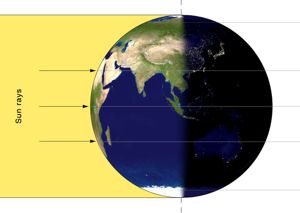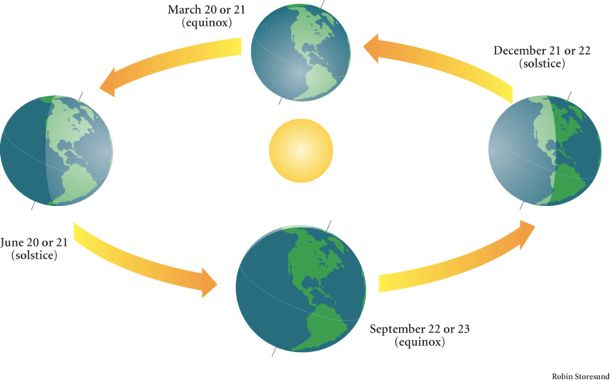Everything you need to know: Vernal equinox 2016

|
|
The March equinox signals the beginning of spring in the Northern Hemisphere – earliest spring since 1896 – and autumn in the Southern Hemisphere. It marks that special moment when the sun crosses the celestial equator going from south to north. In 2016, this equinox arrives on March 20 at 4:30 UTC, or on March 19 at 11:30 p.m. Central Daylight Time. Here’s what we in the Northern Hemisphere know about this equinox. Our sunrise is earlier now, and nightfall comes later. Plants are sprouting. Winds are softening. For us in the Northern Hemisphere, people are enjoying the warmer days of spring. Meanwhile, south of the equator, autumn begins. Follow the links below to learn more about this vernal equinox.
2016 has the earliest spring since 1896
Where should I look to see signs of the equinox in nature?
Does the sun rise due east and set due west at the equinox?
How to translate UTC to your time zone

What is an equinox? The equinox is an event that happens in Earth’s orbit around the sun. Simultaneously, it happens on the imaginary dome of our sky. The imaginary celestial equator is a great circle dividing the sky into Northern and Southern Hemispheres. The celestial equator wraps the sky directly above Earth’s equator. At the equinox, the sun crosses the celestial equator, to enter the sky’s Northern Hemisphere.
Our ancestors didn’t understand the equinoxes and solstices as events that occur in the course of Earth’s yearly orbit around the sun. But they surely marked today as being midway between the sun’s lowest path across the sky in winter and highest path across the sky in summer.
Today, we know each equinox and solstice is an astronomical event, caused by Earth’s tilt on its axis and ceaseless motion in orbit.
Because Earth doesn’t orbit upright, but is instead tilted on its axis by 23-and-a-half degrees, Earth’s Northern and Southern hemispheres trade places in receiving the sun’s light and warmth most directly. We have an equinox twice a year – spring and fall – when the tilt of the Earth’s axis and Earth’s orbit around the sun combine in such a way that the axis is inclined neither away from nor toward the sun.
At the equinox, Earth’s two hemispheres are receiving the sun’s rays equally. Night and day are approximately equal in length. The word equinox comes from the Latin aequus (equal) and nox (night).
But, since Earth never stops moving around the sun, these days of equal sunlight and night will change quickly.
The video below was the Astronomy Picture of the Day for March 19, 2014. They wrote:
When does the line between day and night become vertical? On the equinox, which happens on March 19 or 20, 2016, depending on your time zone. It’s the time of year when day and night are nearly equal. At an equinox, the Earth’s terminator — the dividing line between day and night — becomes vertical and connects the north and south poles. The above time-lapse video demonstrates this by displaying an entire year on planet Earth in twelve seconds. From geosynchronous orbit, the Meteosat satellite recorded these infrared images of the Earth every day at the same local time. The video started at the September 2010 equinox with the terminator line being vertical. As the Earth revolved around the sun, the terminator was seen to tilt in a way that provides less daily sunlight to the northern hemisphere, causing winter in the north. As the year progressed, the March 2011 equinox arrived halfway through the video, followed by the terminator tilting the other way, causing winter in the southern hemisphere — and summer in the north. The captured year ends again with the September equinox, concluding another of billions of trips the Earth has taken — and will take — around the sun.
2016 has the earliest spring since 1896. The March equinox can come on March 19, 20 or 21. And 2016 has the earliest March equinox since the year 1896. Is it a coincidence that 2012 also had the earliest spring since 1896? No. Recall that both 2012 and 2016 are leap years. But 2016’s spring comes even earlier than the spring of 2012.
In a nutshell, this earliest spring is happening because the tropical year, as measured between successive March equinoxes, doesn’t have an even number of days (365.242 days). Our calendar, on the other hand, has an even 365 days in a common year and 366 days in a leap year.
The centennial year 2000 was a leap year, bringing about earlier dates for the March equinox in the 21st century (2001-2100).
However, the suppression of the leap year in the centennial year 2100 will push the dates upward again in the 22nd century (2101-2200). Why is 2100 not a leap year, by the way? It’s because, in 1582, Pope Gregory XIII revised the Julian calendar and stated that leap days should not be added in years ending in “00” unless that year is also evenly divisible by 400 (which 2100 is). Read more about leap years here.
So … four years from now, in 2020, the March equinox will be earlier yet – on March 20 at 3:30 UTC (March 19 at 10 p.m. CDT).
Four years after that, in 2024, it’ll come earlier again – on March 20, at 3:06 UTC (March 19 at 10:06 CDT).
The March equinox comes earlier and earlier every leap year all through the 21st century (2001 to 2100).
If you’re considering Universal Time, the first actual March 19 vernal equinox will come in the year 2044 (March 19 at 23:20 UTC).
The earliest March equinox of the 21st century will occur in the year 2096 (March 19 at 14:03 UTC).
Plus – assuming you’re using Universal Time – the equinox will be on March 20 (Universal Time)for the coming four decades.
Sources: aa.usno.navy.mil and www.astropixels.com.
For the remainder of the 21st century (2001-2100), the March equinox will fall on March 20 or 19. The next March 19 equinox will be in the year 2044.
The equinox won’t happen on March 21 until the year 2102. The March equinox last took place on March 21 in 2007.
A 2012 article in Scientific American said:
Did you know that during the 20th century, March 21 was actually the exception rather than the rule [for the date of the equinox]? The vernal equinox landed on March 21 only 36 out of 100 years — most of these occasions coming during the early and middle part of the 20th century. Yet from 1981 to 2102, Americans celebrate the beginning of spring no later than March 20. Still, for many March 21 is ingrained in our culture as the traditional first day of spring, even though it’s been more than 30 years since that last happened.

Image from 2011, via Geosync
Where should I look to see signs of the equinox in nature? The knowledge that spring is here – and summer is coming – is everywhere now, on the northern half of Earth’s globe.
If you live in Earth’s Northern Hemisphere, you’ve likely been noticing the earlier dawns and later sunsets for some weeks now.
Also notice the arc of the sun across the sky each day. You’ll find it’s shifting toward the north. Birds and butterflies are migrating back northward, too, along with the path of the sun.
The longer days bring with them warmer weather. People are leaving their winter coats at home. Trees are budding, and plants are beginning a new cycle of growth. In many places, spring flowers are beginning to bloom.
Meanwhile, in the Southern Hemisphere, the days are getting shorter and nights longer. A chill is in the air. Fall is here, and winter is coming!

Does the sun rise due east and set due west at the equinox? Yes, it does. And that’s true no matter where you live on Earth, because we all see the same sky.
No matter where you are on Earth, you have a due east and due west point on your horizon. That point marks the intersection of your horizon with the celestial equator – the imaginary line above the true equator of the Earth.
At the equinoxes, the sun appears overhead at noon as seen from Earth’s equator, as the illustration at left shows. This illustration (which is by Tau’olunga) shows the sun’s location on the celestial equator, every hour, on the day of the equinox.
That’s why the sun rises due east and sets due west for all of us. The sun is on the celestial equator, and the celestial equator intersects all of our horizons at points due east and due west.
This fact makes the day of an equinox a good day for finding due east and due west from your yard or other favorite site for watching the sky. Just go outside around sunset or sunrise and notice the location of the sun on the horizon with respect to familiar landmarks.
If you do this, you’ll be able to use those landmarks to find those cardinal directions in the weeks and months ahead, long after Earth has moved on in its orbit around the sun, carrying the sunrise and sunset points northward.
So enjoy the 2016 spring equinox on March 20 (or March 19, depending on your time zone) – an event that happens on our sky’s dome – and a seasonal marker in Earth’s orbit around the sun!
Bottom line: In 2016, the vernal equinox comes on March 20 at 4:30 UTC, or 1130 p.m. Central Daylight Time for us in the central U.S. Everything you need to know about the equinox, here.